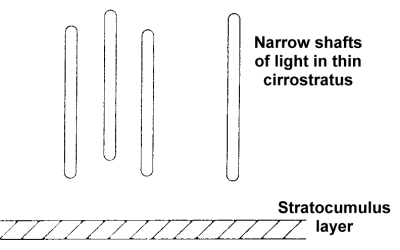 |
Science Frontiers ONLINE No. 126: Nov-Dec 1999 |
|
|
Towering Shafts Of Light
Ice crystals in the atmosphere can dazzle us with bright haloes, sundogs, and similar optical phenomena -- as long as the sun or moon are shining. Sometimes, though, human light sources will create remarkable displays using the same ice crystals. The first of the two examples below is notable for its extreme height; the second provides the accepted explanation.
August 24, 1998. South China Sea. Aboard the m.v. Oriental Bay, Hong Kong to Singapore.
"Four shafts of narrow vertical light were observed reflected in the sky. Upon consulting the chart it was revealed that they were 'reflections' of the four flares of the Kakap Natuna oil terminal, which at this point was 75 n mile away.
"As indicated in the sketch, the shafts of light were visible above a lower layer of stratocumulus cloud, and, when measured by sextant, their upper tips were calculated to be nearly 13 km high. The shafts appeared to be reflected in a thin layer of cirrostratus and, as the vessel approached to 60 n mile from the terminal, the glow from the flares was also visible on the horizon."
(Peterson, J.L.; "Optical Phenomenon," Marine Observer, 69:110, 1999.)
 | Tall light pillars rise over the South China Sea |
February 4, 1999. Toyama Bay, Japan. The caption quoted below is located beneath an impressive color photograph of five tall pillars of light reaching up into the night sky.
"Rare beams of light rise to the upper atmosphere over Toyama Bay on Thursday. The lights appeared about 2,000 meters above fishing boats with fires aboard to attract squid, for about 20 minutes from 8 p.m. The night illuminations are a rare natural phenomenon in which lights on the ground are reflected in the hexagonal crystals that form in the cirrostratus. According to experts, the phenomenon can only be observed in ideal weather conditions when the height of the cloud matches the distance from the source of the light to the observer."
(Anonymous; Daily Yomiura, February 7, 1999. Cr. N. Masuya.)
Comment. Note that the light source in the first case is much farther away than the height of the clouds -- the condition stipulated in the second case!
Sun pillars resemble the light shafts described above. D. Steel has recently mused that a sun pillar might well have been the natural phenomenon that convinced the Roman Emperor Constantine of the truth of Christianity!
(Steel, Duncan; "A Sun Pillar That Changed the World," Sky & Telescope, 98:12, October 1999.)